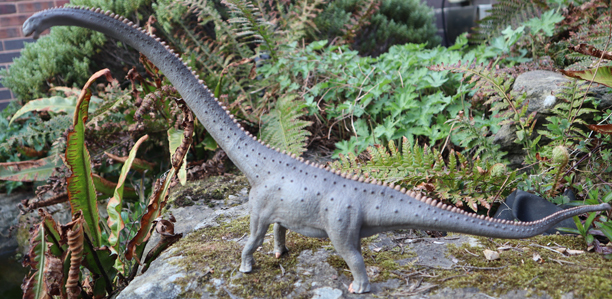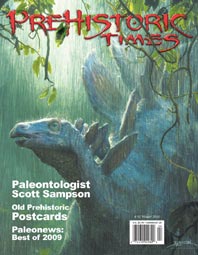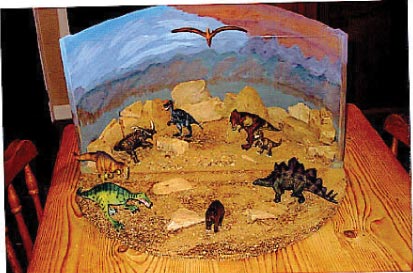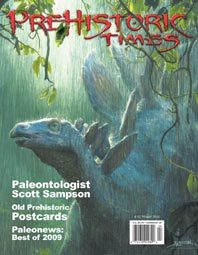New Study Indicates Alligators Breathe Like Birds – Implications for the Rise of the Archosaurs
The greatest known extinction event took place some 250 million years ago, at the Permian/Triassic boundary. A lot of groups of animals disappear from the fossil record at this point, never to be found as fossils in younger rocks. This period in Earth’s history did not just mark the end of one geological period and the start of another but scientists made this boundary the end of the Palaeozoic era and the start of the Mesozoic. Nearly 60% of all marine families became extinct. Virtually all the coral species (rugose and tabulate corals), became extinct, along with the last of the trilobites. Other invertebrate groups such as brachiopods, gastropods and crinoids were devastated. Vertebrates did not cope much better with many marine species becoming extinct and large numbers of reptilian and amphibian families being wiped out. An estimated 70% of all terrestrial vertebrate genera died out.
The reasons as to why this mass extinction event occurred remain unclear. However, as a consequence of this mass extinction, one of the most significant changes in mega fauna can be identified in the fossil record of the Early Triassic. During the Triassic, the synapsids, one clade of reptiles that had dominated terrestrial life, a group whose descendants are modern mammals, went into dramatic decline. In contrast, diapsids, particularly the archosaurs, the ancestors of crocodiles, pterosaurs, birds and dinosaurs diversified and came to dominate terrestrial food chains.
There may be many reasons for this, fundamentally the Archosauria seemed better adapted to the environmental conditions around on planet Earth in the Early Triassic, when compared to the majority of their synapsid rivals. A new study to be published in the scientific journal “Science” may provide some clues as to why one particular group of reptiles were more successful than other groups. It has all to do with the way in which an Alligator breathes.
Researchers at the University of Utah (United States) have found the Alligators have a uni-directional air flow in their lungs, this is similar to that found in modern birds. However, although both archosaurs, Alligators and birds represent different branches in the archosaur family tree. The development of an efficient lung function, more efficient in certain ways than the lung function of synapsids, could have given archosaurs the crucial advantage required in the harsh Triassic world to see them and not the synapsids go onto dominate terrestrial mega fauna.
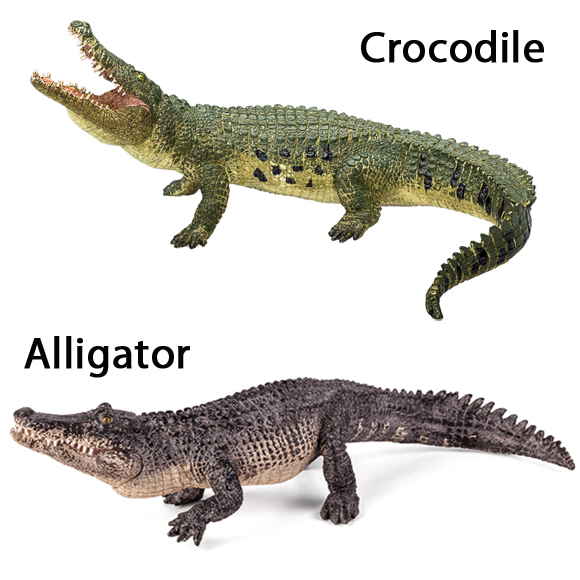
Crocodile (top) and Alligator (bottom).
For models of ancient archosaurs including prehistoric crocodilians: Prehistoric Animal Replicas and Scale Models.
Birds have a very efficient lung function with de-oxygenated air kept separate from oxygenated air as it is expelled from the lungs. With mammals such as ourselves (H. sapiens), used air we breathe out gets mixed with fresh air we breathe in. Birds have more efficient lungs than mammals, so much the better to get oxygen to muscles to help power flight. However, this new American study demonstrates that Alligators too, have this efficient one-way breathing system, indicating that this type of lung adaptation was present in both branches of the archosaurs, the bird line and the crocodile line.
Low oxygen levels in the Early Triassic would have meant that archosaurs with their efficient lungs would have been able to sustain activity longer than the synapsids and this may have given the archosaurs the opportunity to supplant the synapsids as the dominant large terrestrial animals – hence the rise of Dinosauria.
This is one of the conclusions made by the team of scientists who have studied the lung function of one extant archosaur, a member of the crocodile-like archosaur lineage, the American Alligator (A. mississipiensis).
Assistant Professor of Biology (University of Utah), and lead author of the research paper, Colleen G. Farmer stated:
“The real importance of this air-flow discovery in gators is it may explain the turnover in fauna between the Permian and the Triassic, with the synapsids losing their dominance and being supplanted by these archosaurs.”
Colleen went on to add:
“Even with much less oxygen in the atmosphere, many archosaurs, such as pterosaurs, apparently were capable of sustaining vigorous exercise. Lung design may have played a key role in this capacity because the lung is the first step in the cascade of oxygen from the atmosphere to the animal’s tissues, where it is used to burn fuel for energy.”
Assistant Professor Farmer, stated that this particular piece of research work did not necessarily help to explain the rise and dominance of the dinosaurs. Within the two main types of archosaur, there are anatomical differences. Perhaps the mesotarsal ankle of the dinosaur and bird lineage which gave these types of animals greater mobility on land when compared to the crurotarsal ankle of the crocodile-like archosaurs, may be the answer.
She went on to comment:
“Our data provide evidence that unidirectional flow [of air in the lungs] predates the origin of pterosaurs, dinosaurs and birds, and evolved in the common ancestor of the crocodilian and bird [and pterosaur and dinosaur] lineages.”
In the lungs of humans and other mammals, airflow is like the tides. When we inhale, the air moves through many tiers of progressively smaller, branching airways, or bronchi, until dead-ending in the smallest chambers, cul-de-sacs named alveoli, where oxygen enters the blood and carbon dioxide moves from the blood into the lungs.
It long has been known that airflow in birds is unidirectional, and some scientists suggest it also was that way in dinosaurs.
In modern birds, the lungs’ gas exchange units are not alveoli, but tubes known as “parabronchi,” through which air flows in one direction before exiting the lung. Farmer says this lung design helps birds fly at altitudes that would “render mammals comatose.”
Some researchers have argued that unidirectional airflow evolved after crocodilians split from the archosaur family tree, arising among pterosaurs and theropod dinosaurs, the primarily meat-eating group that included Tyrannosaurus rex. Others have argued it arose only among coelurosaurs, a group of dinosaurs that also includes T. rex and feathered dinosaurs.
To read an article on the relationship between Avian and Dinosaur lungs: Ideas on Dinosaur Breathing – A Breath of Fresh Air.
Unidirectional air flow in birds long has been attributed to air sacs in the lungs. But Farmer disagrees, since gators don’t have air sacs, and says it’s due to aerodynamic “valves” within the lungs. She believes air sacs help birds redistribute weight to control their pitch and roll during flight. Farmer says many scientists simply assume air sacs are needed for unidirectional airflow, and have pooh-poohed assertions to the contrary.
“They cannot argue with this data, “I have three lines of evidence. If they don’t believe it, they need to get an alligator and make their own measurements.”
Farmer and her team conducted several types of experiments on Alligators to assess their lung function, working with live and dead specimens. The research involved the use of CT scans on a metre long Alligator to assess the flow of air, plus surgery on Alligators to insert flow meters into the lungs and autopsies and experiments on the dead animals. The CT scans were performed with the help of Kent Sanders Associate Professor of Radiology at the University of Utah School.
Computerised tomographic (CT) X-ray images of side and top views of a 24-pound American alligator, with 3-D renderings of the bones and of airways or bronchi within the lungs. The windpipe and first-tier of bronchi are not shown. A University of Utah study found that air flows in one direction through a gator’s lungs. It flows from the first-tier bronchi through second-tier bronchi (blue), then through tube-like third-tier parabronchi (not shown) and then back through other second-tier bronchi (forest green). (Credit: C.G. Farmer and Kent Sanders, University of Utah.)
Note: lateral and dorsal views
Farmer says the fact Alligator lungs still had unidirectional flow after being removed shows unidirectional airflow is caused by aerodynamic valves within the lungs, and not by some other factor, like air sacs or the liver, which acts like a piston to aid breathing.
How does air loop through an alligator’s multichambered lungs?
Inhaled air enters the trachea, or windpipe, and then flows into two primary bronchi, or airways. Each of those primary bronchi enters a lung.
From those primary airways, the bronchi then branch into a second tier of narrower airways. Inflowing air jets past or bypasses the first branch in each lung because the branch makes a hairpin turn away from the direction of airflow, creating an aerodynamic valve. Instead, the air flows into other second-tier bronchi and then into numerous, tiny, third-tier airways named parabronchi, where oxygen enters the blood and carbon dioxide leaves it.
The air, still moving in one direction, then flows from the parabronchi into the bypassed second-tier bronchi and back to the first-tier bronchi, completing a one-way loop through the lungs before being exhaled through the windpipe.
Our thanks to the following reference source for helping to compile this article:
University of Utah (2010, January 15). Alligators breathe like birds, study finds. ScienceDaily.


